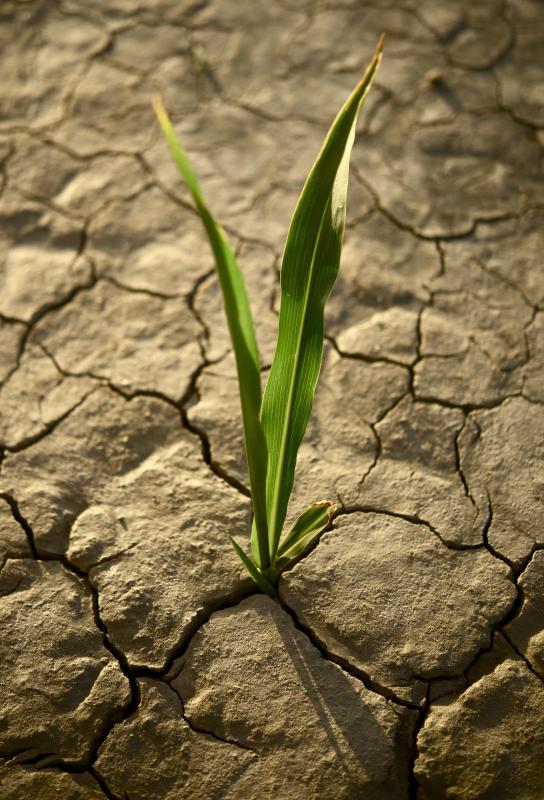At AllThingsNature, we're committed to delivering accurate, trustworthy information. Our expert-authored content is rigorously fact-checked and sourced from credible authorities. Discover how we uphold the highest standards in providing you with reliable knowledge.
What is a Drought?
A drought is a climate event marked by a prolonged period of decreased rainfall. Droughts are in fact part of the natural climate cycle in many regions of the world, but they can still be extremely disruptive, especially when the impact of the drought is increased by human activities. Drought conditions are of interest socially, politically, economically, and environmentally, and at any given time, several regions of the world are often experiencing dry conditions.
In a simple meteorological drought, rainfall is lower than average, or lower than expected, for a period of several months. This can deepen into a hydrologic situation, in which overall water supplies are low and conflicts over water resources may emerge, in which case an agricultural drought, in which crops and livestock suffer, may also emerge.

Droughts can be accompanied with major climate changes, such as an increase in average temperatures, or unusually high winds. The hot, dry weather can contribute to desertification, and it can also lead to dust storms and wildfires. Arguments over natural resources can become extremely fraught during drought conditions, as for example when two nations go to war over a shared water source on the border, or when people migrate en masse to find land which is not suffering from drought.

A number of changes can occur in the natural environment during a drought. Algae tends to proliferate in water sources because of the elevated temperatures and decreased water supply, and the algae blooms can choke out fish species and make animals sick. The landscape may also change radically as plants, trees, and shrubs die from lack of water, and hardy opportunistic species move in to eke out a living. This can also change the animal demographics in the natural environment, with drought-sensitive animals disappearing along with fragile plants.

When regions or nations suspect that drought conditions are emerging, they often take steps to reduce the impact and raise awareness. Citizens may be asked to be more careful about their water usage, for example, and arrangements can be made to ship in water from other locations to keep water supplies stable. Appeals may also be made for international aid in the form of water supplies, food to replace damaged crops, and peacekeeping troops to deal with outbreaks of violence over scarce resources.
Recovery can take some time, even as rainfall starts to return to normal levels. The snowpack usually shrinks radically, decreasing the supply of stored water, and the land may need careful tending to recover as plants and animals re-establish themselves. The social chaos which severe droughts can cause may also have long lasting repercussions.
Frequently Asked Questions
What exactly is a drought?
A drought is a prolonged period of abnormally low rainfall, leading to a shortage of water. It can last for months or years, significantly impacting ecosystems, agriculture, and water supply. The severity of a drought is measured by its duration, the degree of moisture deficiency, and the size of the affected area.
How does a drought affect the environment?
Droughts can have devastating effects on the environment, including reduced stream and river flows, lower lake and groundwater levels, and the drying up of wetlands. Vegetation becomes stressed and can die off, leading to soil erosion. Wildlife may suffer from loss of habitat and food sources, sometimes resulting in decreased biodiversity.
What are the primary causes of droughts?
Droughts are primarily caused by a lack of precipitation, which can be due to natural weather variations or climate change. Other contributing factors include high temperatures that increase evaporation rates, and wind patterns that can drive away moisture-laden clouds. Human activities, such as deforestation and poor water management, can exacerbate drought conditions.
Can droughts be predicted?
While it's challenging to predict droughts with complete accuracy, meteorologists use climate models and historical data to forecast the likelihood of drought conditions. Advances in technology and a better understanding of weather patterns have improved the ability to predict droughts, allowing for earlier warnings and better preparation.
What are the economic impacts of a drought?
Droughts can have significant economic impacts, particularly on agriculture, which relies heavily on water. Crop yields can decrease, leading to higher food prices and economic losses for farmers. Water scarcity can also affect industries, energy production, and increase costs for water treatment and transportation, according to the National Drought Mitigation Center.
How can we mitigate the effects of drought?
To mitigate the effects of drought, water conservation is key. This includes efficient irrigation practices, drought-resistant crops, and reducing water waste. Planning and preparedness, such as creating water reserves and improving infrastructure, are also crucial. Public awareness and education on water-saving techniques can help communities adapt to drought conditions.
AS FEATURED ON:
AS FEATURED ON:













Discuss this Article
Post your comments